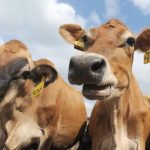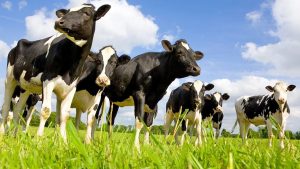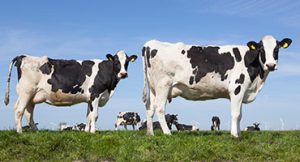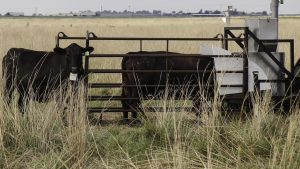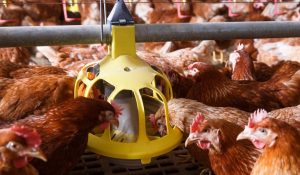
This story will be continually updated as new cases are reported to the Animal and Plant Health Inspection Service.
To date, 36 dairy herds in nine states have been found to be carrying Highly-Pathological Avian Influenza (HPAI), a virus originally found in wild birds and usually associated with turkey and poultry flocks. The first known transmission found in a dairy cow herd was announced on March 25 by the U.S. Department of Agriculture (USDA), with herds in Kansas and Texas suffering from illness and testing positive.
Since the original diagnosis, herds in New Mexico, Ohio, Idaho, Michigan, North Carolina, Colorado, and South Dakota have been identified as carrying HPAI. The USDA has created a webpage with a list of the date each herd was diagnosed.
Symptoms
Some dairy cows have tested positive for HPAI despite being asymptomatic, the USDA said on Wednesday. In a majority of cases, dairy cattle have shown symptoms such as these listed by the Kansas Department of Agriculture:
“Symptoms are mostly restricted to late-stage lactating cows and include a drop in milk production, loss of appetite, and changes in manure consistency. We encourage dairy producers to minimize wildlife access to their dairy cattle’s water and feed sources.”
What the USDA is doing
In response to the growing number of cases and concerns, on April 24 Agriculture Secretary Tom Vilsack announced a mandatory testing ordinance that requires dairy cattle herds to be tested for HPAI before they can be moved across state lines. The order goes into effect on April 29.
“This is an evolving situation,” said Vilsack during a teleconference. “Emergence of this virus poses a bit of a new risk.”
In addition, the USDA said in a press release that the Animal and Plant Health Inspection Service (APHIS) released 239 genetic sequences found in the recent H5N1 and HPAI influenza viruses found in dairy cattle and poultry for interested researchers.
“APHIS is urging dairy cattle producers and those who work in or with the industry to share epidemiological information from affected farms, even if they are not planning to move cattle interstate,” the release stated.
USDA emphasized the CDC’s assessment that humans are at low risk of contracting the disease. One person in Texas has tested positive for contracting H5N1 as of May 9.
While there are no documented cases of bird flu in beef cattle, the USDA announced April 29 the organization would test ground beef from the nine states with confirmed H5N1 cases.
What the FDA is doing
The FDA found particles of HPAI in samples of pasteurized milk as recently as April 23, but in a release said that it has full confidence in the safety of milk sold in grocery stores.
“Based on available information, pasteurization is likely to inactivate the virus, however the process is not expected to remove the presence of viral particles,” the FDA said in a report published by Reuters on Tuesday.
In addition, on April 25 Sid Miller, Texas agriculture commissioner, tried to assuage consumer fears about H5N1 in the commmercial milk supply.
“There is no reason for consumers to panic,” noted Commissioner Miller. “Milk and dairy products remain safe for consumption. Milk from affected cows is discarded before it can enter the supply chain. In the rare event that contaminated milk does enter the supply chain, pasteurization effectively kills viruses even if traces of the virus remain detectable.”
Articles roundup
Successful Farming will continue publishing stories on the HPAI/dairy cow situation. Here is a comprehensive list of our coverage since April 2, 2024:
- April 2: Texas, CDC say bird influenza detected in person exposed to dairy cattle
- April 4: Bird flu dairy cow outbreak widens in Ohio, Kansas, New Mexico
- April 4: CDC: Bird flu virus lacks changes to make it a greater threat to people
- April 9: Hog farmers hope to fly past bird flu
- April 11: HPAI found in dairy cows in seventh state
- April 11: Bird flu pushes U.S. dairy farmers to ban visitors, chop trees
- April 15: USDA: Test for bird flu before interstate transport of cattle
- April 22: USDA assesses vaccine to protect cattle from bird flu virus
- April 22: USDA confirms cow-to-cow transmission a factor in bird flu spread
- April 23: Bird flu virus susceptible to antiviral meds used against seasonal flu, says CDC
- April 24: U.S. FDA says commercial milk safe despite bird flu virus presence
- April 24: U.S. requires bird flu tests for dairy cattle moving between states
- April 25: USDA mandates bird flu tests of dairy cows before transport
- April 25: Colombia becomes first country to restrict U.S. beef due to bird flu in dairy cows
- April 26: Bird flu traces found in one in five U.S. commercial milk samples, says FDA
- April 29: FDA: Bird flu viral fragments in milk were dead; pasteurization works
- April 29: USDA to test ground beef in U.S. states with outbreaks of bird flu in dairy cows
- May 1: Bird flu testing shows more dairy products are safe, U.S. FDA says
- May 2: Bird flu virus likely travels from cow to cow via milk, says USDA
- May 3: H5N1 virus was undetected for months in dairy cattle, researchers say
- May 6: CDC: Texas farmworker only person known to contract bird flu from cattle
- May 6: How bird flu could threaten cow cuddling. Yes, it is a thing.
- May 9: ‘Absolute barrier’ against spread of bird flu virus is impossible, says Califf
You can now read the most important #news on #eDairyNews #Whatsapp channels!!!
🇺🇸 eDairy News INGLÊS: https://whatsapp.com/channel/0029VaKsjzGDTkJyIN6hcP1K


